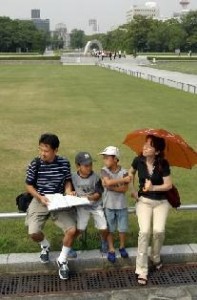Conveying the A-bomb Experience, Part 9
Jul. 5, 2010
Voices call for opening up "sacred place" to better transmit peace
by Kunihiko Sakurai, Masaki Kadowaki, and Takahiro Yamase, Staff Writers
The heat of the atomic fire, the agony of burned bodies, the grief wrought by families torn apart, the rage felt toward war… What should be done to etch the experiences borne of that day in our minds and in our memories, for generations to come, as the A-bomb survivors (hibakusha) and the family members of the A-bomb victims age? In this series (originally published in July and August 2004), the Chugoku Shimbun will consider the significance and challenges of conveying the A-bomb experience, with a focus on new efforts taking place in the A-bombed city of Hiroshima.
A talk with Isamu Noguchi, the celebrated designer, was held in Hiroshima in November 1951. At this talk, Kenzo Tange, 90, who was then an associate professor at the University of Tokyo, explained the concept of Hiroshima Peace Memorial Park, which he himself designed, with the words: "The ground for human relations." He also made the wish: "Let the park be a base where people will build ties among themselves."
A half century has passed since then. The park is not a place of free movement these days. In 1967, the late Setsuo Yamada, then mayor of the city, advocated the idea of "transforming the park into a sacred place" and, as a result, street stalls, meetings, and demonstrations in the park were banned. Now, only once a year on August 6, for the Peace Memorial Ceremony, is it permissible to step onto the lawn, which was once a place of recreation and relaxation.
"It is a place of peace, known to the world. But I find it too restricting. Soon, no one will go there." On July 7, Ayumi Maruyama, 18, a freshman studying international politics at Hiroshima Shudo University, voiced her feelings in a class discussion about Peace Memorial Park.
Security cameras are operating 24 hours a day. Even forming "human letters" to appeal for peace is not allowed as it is regarded as a "gathering." Ms. Maruyama, who read a newspaper article about this prior to the class, was surprised at the large number of regulations at the park. "I wonder if it's really a place to transmit peace," she said. After the class, she got together with several friends to continue the discussion.
Tadaomi Saito, 61, chairman of the Hiroshima Peace Culture Foundation, calls Hiroshima Peace Memorial Park "the only park in the world dedicated to peace." He affirmed: "The park should be a place where the general public can relax and pray for peace."
Momentum has been building among Hiroshima citizens: "Let us create an atmosphere of peace in the park as well as an atmosphere that can console the souls of the A-bomb victims." The Hiroshima Chamber of Commerce and Industry has sketched out a plan to hold a memorial concert with seats for spectators on the lawn in the park, an idea designed to energize the downtown area.
The Junior Chamber International Hiroshima has been pondering how to appeal for peace through music targeted to young people. Keitaro Nomura, 36, vice president of the organization, said, "Everyone perceives peace differently. We should at least be able to make rules, though, that will enable the use of the park without undermining the park's purpose of consoling the souls of the A-bomb victims."
The City of Hiroshima is charged with looking after the park, based on city ordinances and its internal regulations. "We cannot easily dismiss the opinions of our citizens, but the time is not yet ripe for such activities," said Haruo Watarida, 55, head of the city's Greenery Promotion Department, in relating the difficulty of this dilemma.
Sunao Tsuboi, 79, co-chairperson of the Japan Confederation of A- and H-bomb Sufferers Organizations, also hopes for a review of the regulations. His hope for this review began in the wake of the September 11th terrorist attacks in the United States. He felt daunted at the sight of the skyscrapers collapsing in an instant. "It will take more than hibakusha longing for peace," he said. He is now mulling whether he can convey something from the A-bombed city that will widen the circle of empathy among people beyond race and nationality.
Coincidentally, the City of Hiroshima has included a "Hiroshima Peace Concert" in the basic plan of commemorative events for the 60th anniversary of the atomic bombing next year. Musicians from both home and abroad will take part in this concert, though the venue is reportedly not yet confirmed. "Music resonates in people's hearts," said Mr. Tsuboi. "I do hope the concert will be held in Peace Memorial Park. It will stir not only hibakusha, but everyone, to think about peace." He hopes the park will move toward a real "sacred place" where human hearts can be joined.
(Originally published on August 1, 2004)








